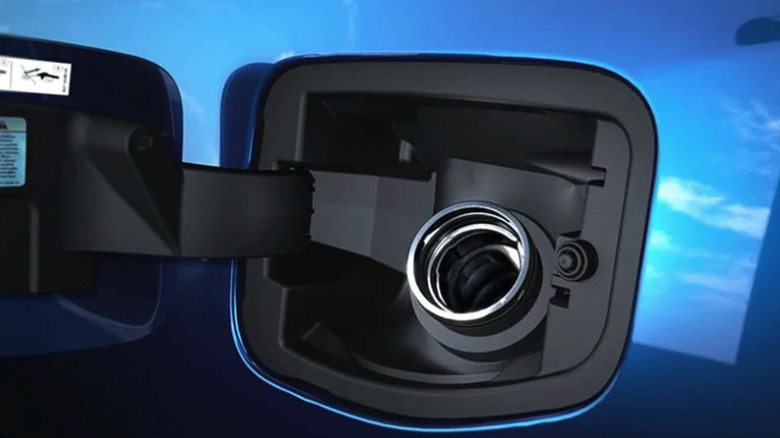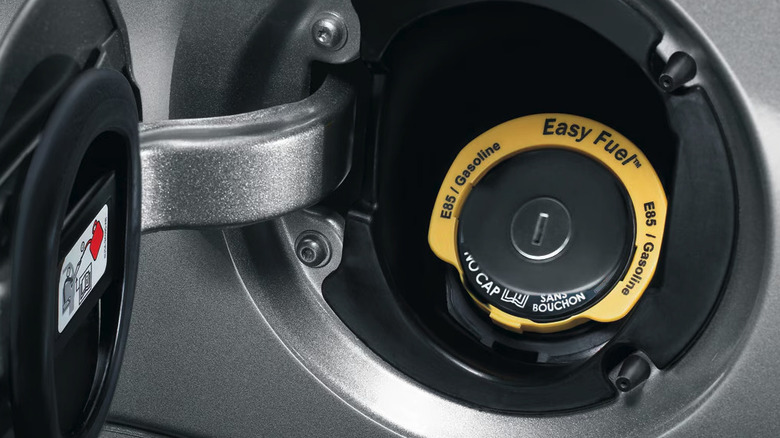Why Don't Some New Cars Come With Gas Caps Anymore?
Most of us grew up with gas caps. Getting your driver's license and learning how to pump gas is a rite of passage for many in the U.S. — and a big part of that is twisting off the gas cap or at least trying to. However, new generations may miss out on this once-familiar ritual, as gas caps are becoming a thing of the past. Whether you're thinking about buying a GMC Sierra 1500 Denali or already own a Ford Mustang GT Premium, you won't be unscrewing a gas cap. That's because Ford and General Motors are just two of the automakers who've done away with gas caps in favor of capless fuel systems in many models.
A big reason behind this move is that capless fuel systems, also known as capless fuel fillers, make it easier to fill up your gas tank. In fact, the process is so straightforward that Ford refers to its gas cap–free design as the Ford Easy Fuel capless fuel filler. Convenience isn't the only benefit; going capless can also help reduce emissions by minimizing the release of fuel vapors, stop people from stealing or tampering with your fuel, and eliminate the need for you to remember to put your gas cap back on after refueling.
What are the benefits of capless fuel systems?
If you belong to the "if it's not broke, don't fix it" school of thought, you might be wondering what makes capless fuel systems so special, and if getting rid of gas caps even makes sense. Many car manufacturers believe the pros of capless fuel fillers outweigh the cons for several reasons. First and foremost, when compared to their screw-on counterparts, capless fuel systems are just more convenient and they speed up the fueling process. If your car has a capless fuel filler, all you have to do is open the fuel door and insert the nozzle; there's no more fumbling with the gas cap when you're in a hurry. You also won't have to worry about driving off with your gas cap on the hood of your car or forgetting to screw it back on, giving you one less thing to think about.
Capless fuel systems like those found on Ford vehicles have self-closing, spring-loaded flaps to keep fuel from splashing out, and moisture from rain or washing your car from getting in. From an environmental standpoint, capless fuel fillers help limit fuel vapor leaks that would otherwise be released into the air during refueling. Capless fuel fillers also increase security, as the designs make it much harder for would-be thieves to siphon your gas or tamper with your fuel. Plus, as there's no cap to remove or handle, your hands are bound to stay cleaner too.
Are there any drawbacks to capless fuel systems?
While capless fuel fillers come with many benefits, nothing is perfect. If you ever find yourself in a situation where you can't refuel directly at the pump, you'll need to use a special funnel to add gas from a can. If you don't have that funnel with you, it'll be difficult, if not impossible, for you to refuel without it. Even with the funnel, you're not going to be able to siphon gas from the fuel tank to help someone else or transfer fuel.
Your hands may stay cleaner when using a capless fuel filler, but there's a chance the gasoline smell will be stronger while refuelling, especially if you try to top off the tank. If your car has a capless fuel system you may have to do some extra maintenance to keep dirt and debris from accumulating around the sealing mechanism. This is a problem that can activate the check engine light, due to small leaks in the evaporative emission system — an issue a few Ford and Cadillac owners have reported in internet forums. While there are many reasons why your check engine light could be on, if your car has a capless fuel filler, it might be worth checking to see if it's the source of the problem.


